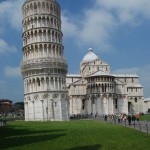PISA (Italy)
The city of Pisa (96,000 residents) is located west of Florence at the mouth of the Arno River –– an ancient small Italian city. It is an extremely popular city, being part of any tour that includes Tuscany. Pisa earned its tremendous fame because of its Leaning Tower.
In middle ages, when the Arno River freely reached the Mediterranean Sea, the city was a port, where the empire was involved in trade with Corsica, Sardinia and the Balearic Islands. From XI till XIII centuries, Pisa reached its blossom, but in 1284 it suffered a grandiose defeat from Genoa’s army in a sea battle at Meloria. As a result of an economic recession, Pisa became dependant of Florence. But under headship of the Medici it once again became stable: economically –– due to development of the port, and culturally –– after opening of a university. Nowadays, Pisa is profited by millions of tourists and students, who come to the city to see the famous tower, museums, cathedrals and the university. Because of the university there are many inexpensive restaurants in the city, where there are few tourists; one only needs to go down the river’s bank to find a real trattoria.
The buildings of the cathedral complex Piazza dei Miracoli (Square of Miracles) tells us about the golden age of the sea republic. Santa Maria Majore Cathedral is rising in its center –– famous for its size; west of it there is famous Baptistry (it was begun in 1153, the construction was finished during the Gothic period); to the left the famous campanilla (bellfry) that entered the history of art under the name of the Leaning Tower is rising. This cathedral ensamble is unrivaled. The three buildings of the complex –– the Cathedral, Baptistry and Leaning (Pisa) Tower –– are made of white shining marble.
Pisa’s Cathedral Temple may claim the right to be the most important Roman cathedral in the world. Its construction began in 1063. It was overseen by architect Buceto, who was buried by the cathedral’s wall after he died (his tomb can be seen there up to this day). In 1064, the soil underneath the cathedral lowered, and work was resumed only in XIII century. The cross-shaped building is richly clothed in marble and decorated. The Pisa cathedral with its numerous pillars and colour marble finishing served as a pattern for constructing similar Roman Pisa churches throughout the entire Italy. The cathedral is famous first of all for its bronze southern doors (1180), Cimabue’s mosaics in the apse “Christ in Glory” (1302) and an amazing platform by Giovanni Pisano. In front of it a lamp is hanging, the so-called Gallileo’s lamp, which might have shone to the famous scientist when he studied the move of a pendulum. A platform as amazing as this one (around 1260) by Giovanni’s father Nicola Pisano is in the round Baptistry. On Camposanto’s walls medieval frescoes remain; one of them tells us about a plague epidemic that emptied the entire city in 1348. Treasuries from the cathedral and Baptistry can be seen in Museo del Opera del Duomo located nearby.
Another place of note on Campo Square is medieval Camposanto Monumentale (the monumental cemetery). The wall along the northern side of Campo dei Miracoli belongs to the cemetery. The construction was begun in 1277 around the famous relics –– soil brought by crusaders from the Holy Land. Camposanto was destroyed by bombings during WWII but then was restored, and the frescoes that remained were exhibited in a special gallery.
The erecting of the Pisano Tower was begun in 1173 but because of the sandy silt undersoil the tower began sliding sideways right away after the first floor was constructed. The building was stopped until 1275, when a genius architect Giovanni di Simone tried to straighten the bellfry erecting each next floor according to the vertical axis. The Leaning Tower became almost the most famous sight of interest in the world. Its height is 60 meters, and it leans 5 meters from the perpendicular line. In fact, many buildings in Pisa stand at a slight angle because of the landslides, but the tower’s leaining after WWII began to increase. The tower was circled with metal supporting belts, the last of which was removed in 2001. Visitation into the tower was reopened but with strictly designated rules. A tourist group of 40 people can ascend 300 steps every 40 minutes.
Pages: 1 2
Один комментарий
Leave a Comment
You must be logged in to post a comment.


Hi there it’s me, I am also visiting this web
site on a regular basis, this website is in fact pleasant and the viewers are actually sharing nice thoughts.